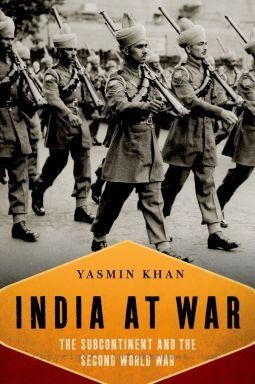World War II is mostly discussed in terms of Allies versus the German forces and Hitler’s friends in Italy and Japan. What gets eclipsed in the fight between Britain and Germany are the sacrifices made by thousands from the British Empire across the world. As the author says, it may have been Britain’s war, but the Empire fought it.
Yasmin Khan is the award winning writer of The Great Partition: The Making of India and Pakistan and Associate Professor of History at the University of Oxford. The author covers the World War from the perspective of Indians living in villages, working on the docks and those fighting the war alongside soldiers of various nationalities. It is the history that is rarely acknowledged or told in the Indian education system.
 India At War: The Subcontinent and the Second World War
India At War: The Subcontinent and the Second World War
Author: Yasmin Khan Pages: 432 Publisher: Oxford University Press; 1 edition (September 1, 2015) ISBN: 0199753490, 978-0199753499
Indian nationalists had a difficult choice to make in the early stages of the war. The movement for independence from Britain was gathering speed and it was difficult to go back to people and ask them to support and participate in the War that many saw as simply not theirs. Yet, by the end of the war the British Indian Army was 2 million men strong.
Millions joined the troops to fight in foreign lands for a foreign country. The soldiers of the 6th Rajputana Rifles were fighting from the Mediterranean to East Asia. While nearly thirty-one thousand troops under General Wavell were fighting in North Africa and had destroyed ten Italian divisions, captured 130,000 prisoners and covered 500 miles.
Those living in India were coerced to make contributions to the War chest . At the same time, all the major stakeholders in British India had their reasons to show loyalty to the Empire. The Royalty was losing its power and came forward with huge donations to the war effort in hopes of prolonging their elite status and special benefits. Businessmen saw war as an opportunity to win government contracts and earn unprecedented profits from the war. It was a time of confusion as loyalty to the British was challenged and at the same time joining the army was considered a lucrative option for many.
British India faced its biggest threat with entry of Japan and its march towards the east coast of India. The Indian troops sent West were recalled as the country’s defenses were weakened by this migration. Fall of Burma brought the war close as thousands of refugees traveled on foot to return to Indian villages to escape the invading Japanese army.
But India was not prepared for war on its soil. The war reaching the Indian shores was not thought of. This lack of readiness meant chaos and hardships for the locals living on the eastern coast. The Japanese occupation in the east was gaining strength. Formation of the Indian National Army and Subhas Chandra Bose’s leadership proved to be another threat to British India. But the initial enchantment of seeing the Japanese as saviors soon dwindled as Indians in the east were coerced to join the INA and forced into labor by the invading Japanese.
The Japanese threat was real. A lot happened before the Japanese finally pushed into Imphal in 1944. The Allies were ready by now and the eastern force had soldiers from across the world including Canadians, from Africa and the Gold Coast, USA and China. All fighting the Japanese for Britain. The Battle of Imphal and Kohima was perhaps the bloodiest on Indian soil and closest the natives came to World War II.
Indian Army lost close to 80,000 to the war. Despite its huge contributions in life, money, and material, this history of the Indian Army is rarely discussed in India or in Britain. India At War is the first World War II book I have come across that chronicles India’s contribution to the decisive war of the last century. Lost and forgotten, these brave souls deserve the same place in the Indian history as that of those who perished in other Indian wars.
India At War is India’s World War II history. History that begs to be told and celebrated across India and Britain to honor the 80,000 who lost their lives protecting democracy, at a time when democracy and freedom was still alien to them.